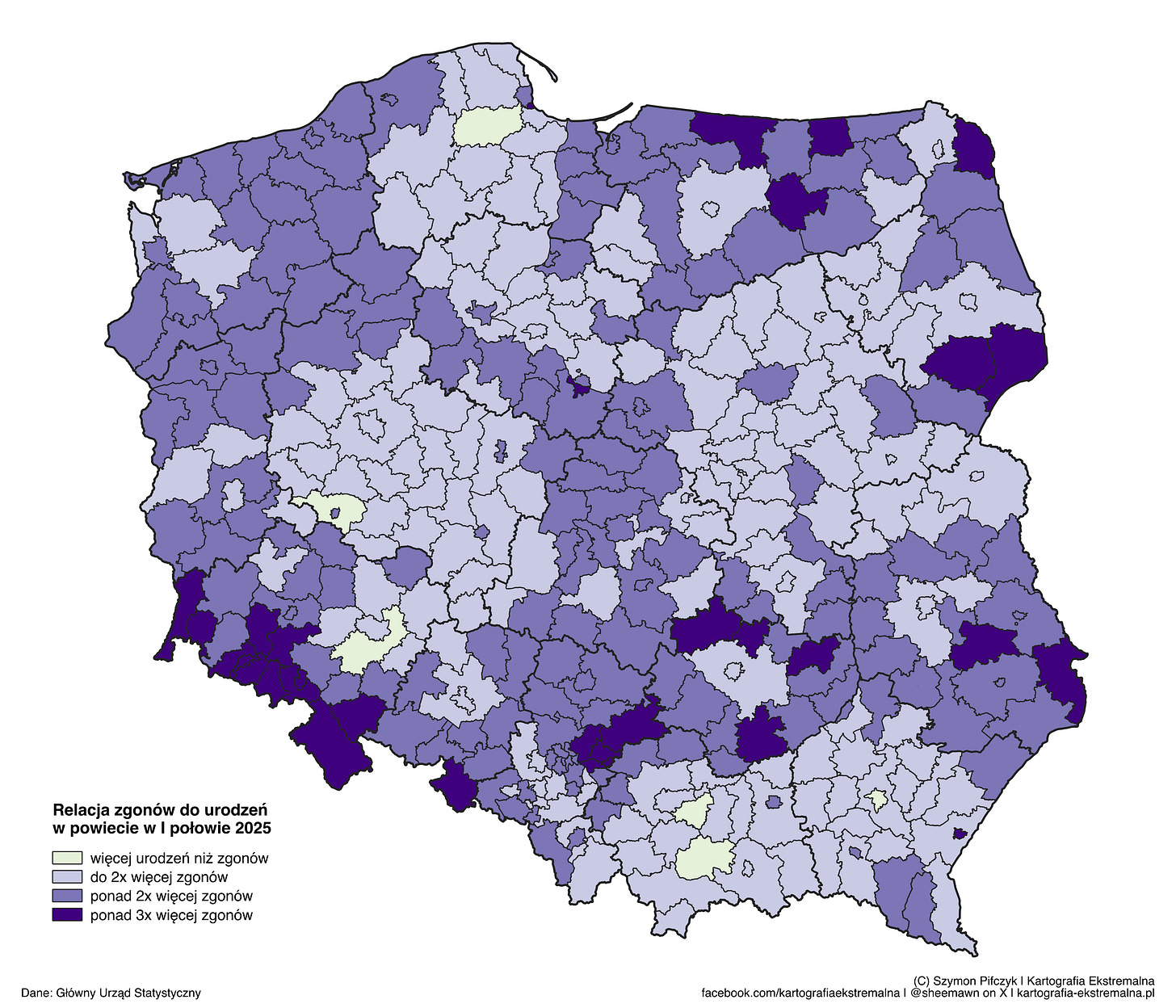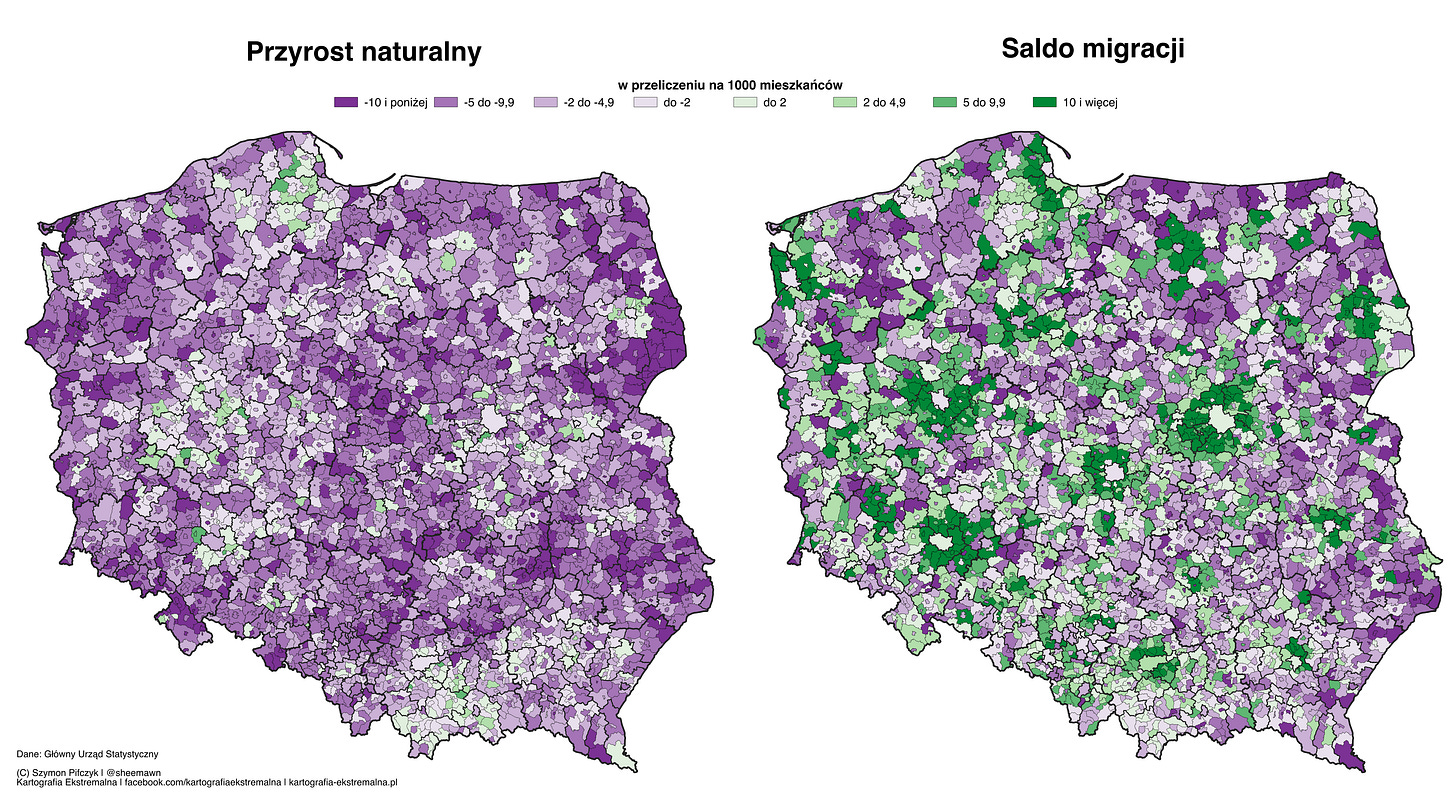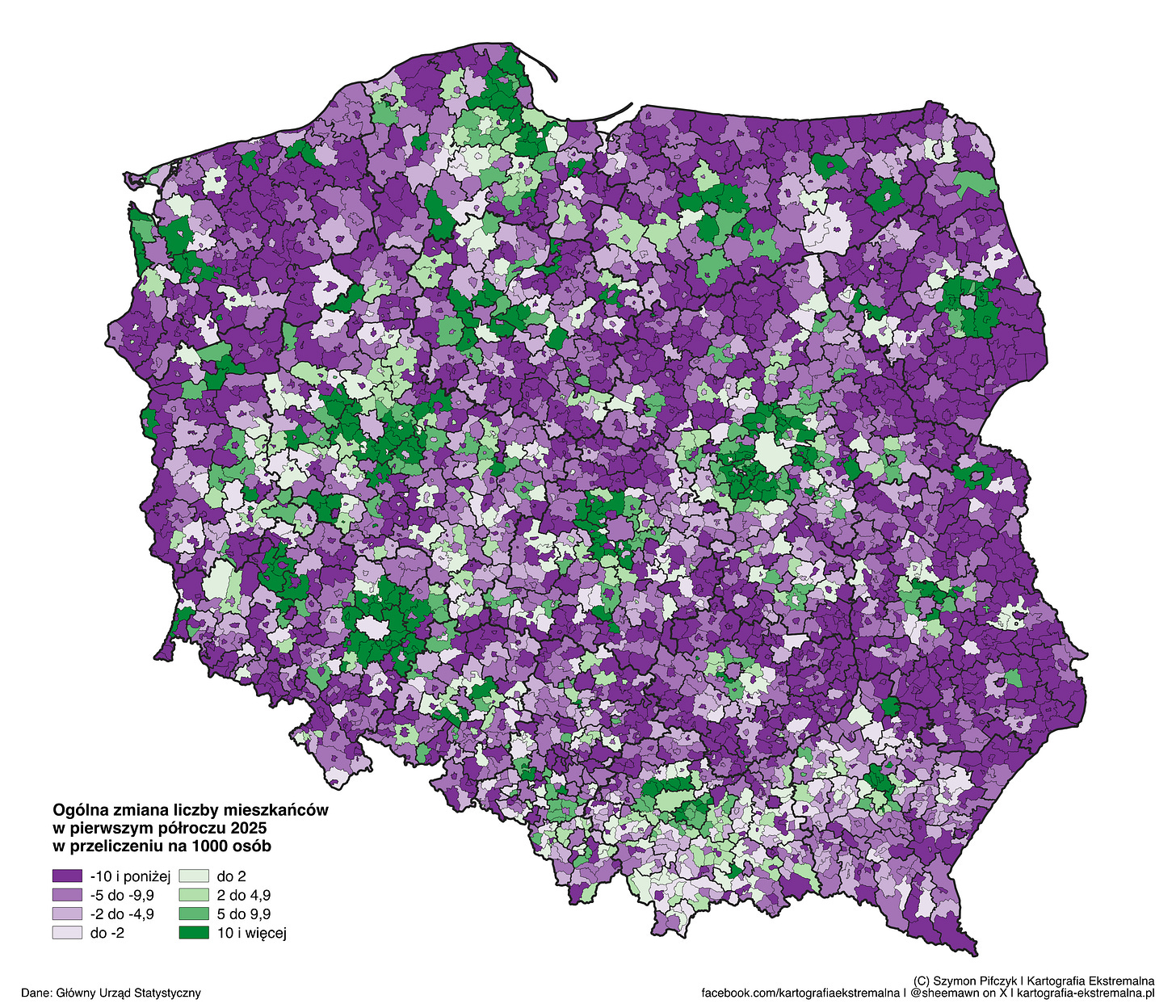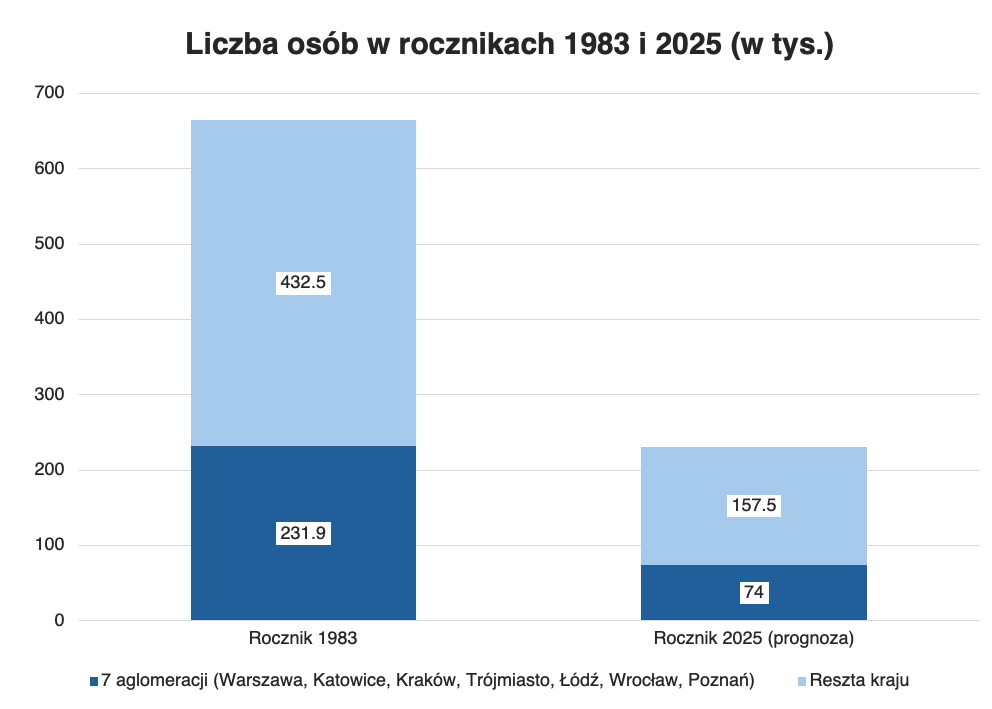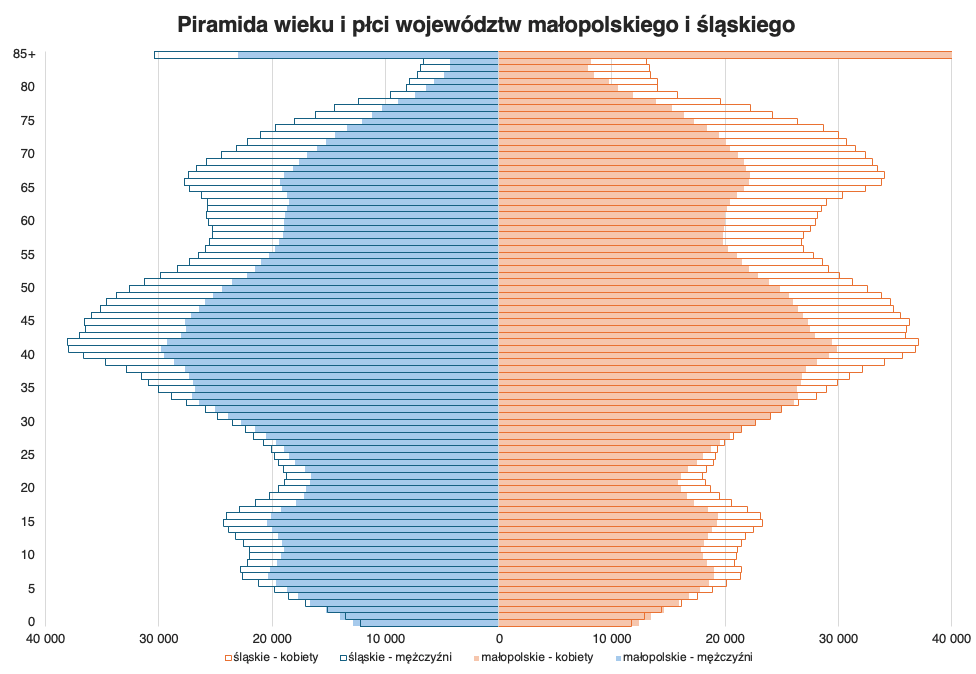Note: This entry is published without a paywall — in the coming weeks, we will compose what depopulating the country will mean in practice over the next decades. We encourage you to subscribe today, Here. or na Patronite. At the incentive, subscribers buying subscription for the full year in advance until 1 November we offer 30% discount on Substack.
The Central Statistical Office published the latest data on the Polish population, as at 30 June this year. They show the image of the disaster:
Only 115.755 children were born — 7.9% little than a year earlier
208.364 people died — 2.5% more than a year earlier
The balance of abroad migration improved somewhat — from 4.286 in the first half of last year to 5.574 people including
In total, Poland's population decreased by 87.035 in six months, i.e. as if Jastrzębie-Zdrój or Słupsk had disappeared. A year earlier at the same time there was besides a decrease, but by 73.437 people, i.e. by a smaller town (such the size of Konin or Mysłowice).
Of course, it was not as bad everywhere, but in any places it was even worse than the above data indicates.
The situation with natural growth is worst. Only in 6 districts (mainly suburban, although besides in Rzeszów) there were more births than deaths, but in as many as 36 districts per birth were more than 3 deaths, and in the next 174 minimum 2 deaths! Together it is more than half the countyes in the country. The most crazy rate of depopulation is affected by the Sudecki region, the Dąbrowskie Basin and many peripheral districts in east Poland.
How large is this deterioration of the statistic should be demonstrated by the fact that only 5 years ago there was not a single region in which the number of deaths would have been higher than the number of births 3 times or more, only 20 counties where the ratio was 2:1 or more and 82 counties with affirmative natural growth.
Because the natural failure is so great, there was not a single state in the first half of 2025 whose population increased. The nearest population was Pomeranian, but even there the population fell by 713 people (0.3 people per 1,000 inhabitants). akin rate of depopulation was besides achieved by Mazowiecki (-0.3) and Małopolskie (-0.4). At the another end of the table, in the “spiral of death” we will find Świętokrzyskie (-4,7), Lublin (-4,4) and Łódź (-4).
Although the migration balance did not overcome the natural failure in any of the voivodships, the situation is somewhat different at the level of municipalities and powiats. Let's first look at 2 maps of the municipalities below. On the left we see a natural growth — there were only 319 municipalities (or parts of municipalities in urban-rural municipalities) in which it was affirmative or zero. Even the last bastions of affirmative natural growth — Kashubians, Wielkopolska, and the area of Nowy Sącz — either light or completely faded. The map on the right already has much more green. This is simply a migration balance — there are inactive many communes in Poland that have affirmative ones. Especially of course, suburban municipalities around the alleged large 5 cities stand out, but besides most another provincial cities.
If we put these maps together, we'll see something interesting. While on the maps above we had a large number of municipalities with average population changes due to the migration balance or natural growth — between 2-5 and 5-10 people per 1000 inhabitants — we have 2 Polish people standing in a immense contrast on the map below. The vast majority of municipalities are either in the worst category or in the best category, i.e. either negative natural growth and negative migration balance increase each another there, or somewhat negative natural growth is mostly offset by affirmative migration balance.
It is not hard to imagine that in this second category we will find agglomerations of the large 5 and suburban areas of another provincial cities (although alternatively but Gorzów, Kielce, Katowice, Opole and Toruń). In the first 1 is almost the remainder of the country, a state that virtually dies in front of our eyes.
The city itself is not in its best form either. In the first half of this year there were only 4 cities with region rights, whose population increased:
Kraków (+1422), Gdańsk (+509) and Warsaw (+190) increased entirely due to the affirmative balance of migration (i.e. the natural growth was negative, but the migration balance compensated it accordingly)
Rzeszow — a actual evolution — rose by 223, of which 58 thanks to affirmative natural growth and 165 thanks to affirmative migration balance
Everywhere else there were larger or smaller inheritances. Włocławek, Konin and Chełm (more than 0.8% in six months!) were the fastest to depopulate.
However, it is worth briefly returning to those cities that have gained their inhabitants. due to the fact that even with this tiny example, we see the depopulation of the state sooner or later reaching large cities. Why is Kraków in front of Warsaw, even though it is simply a smaller city and inactive offers little opportunities than the capital? The answer is simple — Krakow inactive has districts and municipalities that are comparatively young and have young people to send to the city. Warsaw no longer has this comfort — it drained the erstwhile Congressional to the ground. It'll only get worse in the future. If trends from the first half of the year proceed until the end of the year, in 2025 less children will come to the planet in 2025 than presently people from the year 1983 live in only the 7 largest urban agglomerations!
It's hard to imagine. The 1983 yearbook was record-breaking, it is simply a fact, but mostly the 1980s and early 1990s were two- or even 3 times as popular as the presently born yearbooks. How will Poland function in 30 years, erstwhile request for everything, from housing to buses, cars (but besides labour supply) will be 3 times smaller than today? Not to mention any municipalities (now there are four: Nowe Warpno, Krynica Morska, Dubicze Cerkiwe and Baligród) in which no kid was born, and in the following 26 at most 3 were born. Where do these kids go to school erstwhile they learn to work in a group?
Finally, a curious fact. Demography has it against itself that it long seems not so bad, but then collapse strikes abruptly and with large force. For example, the Śląskie voivodship has had a much worse fertility rate than the Lesser Poland region (although the distance is decreasing), and for 2 decades there has been a negative migration balance, erstwhile in Małopolska (thanks to Krakow) it is positive. And this year we see this shocking effect – in Silesia less children were born than in Lesser Poland (and besides in Greater Poland, but it is on the margins), even though Silesia inactive has 1/4 (nearly a million people) inhabitants more than Małopolska.
If we look at the pyramid of the age of the population, the origin becomes clearer – the Silesian people have just quite a few old people, but among young people there are about as many of them, due to the fact that those older people in Silesia had less children, and the ones they had frequently went to Małopolska. The next generation in Silesia will be smaller than in Lesser Poland, in which the next generation will be half as tiny as the 1 that starts having children today. If nothing changes, in 100-150 years there will be virtually no Poles - neither in Silesia nor in Lesser Poland.

